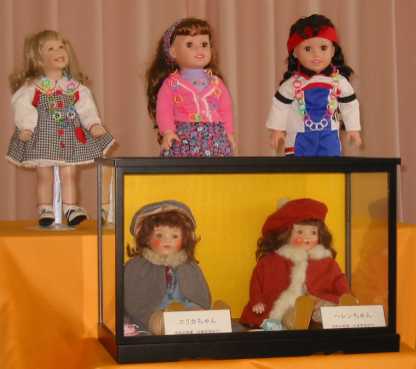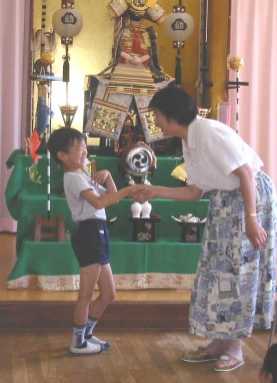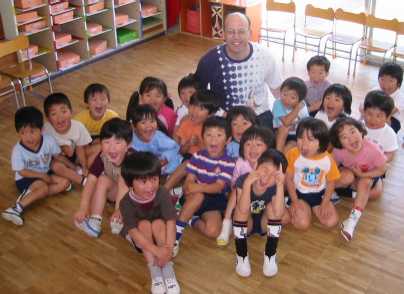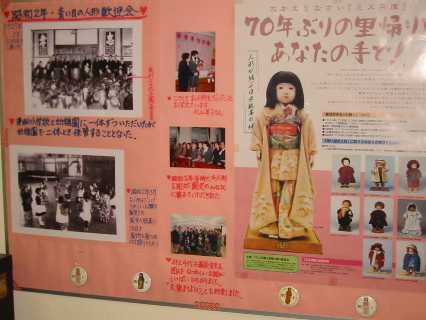|
|
|

|

|
Large Family of Friendship Dolls
|

|
My wife Noriko and I first saw Erika and Helen, Takasago Kindergarten's
two American Friendship Dolls from 1927, at the Friendship Doll Exhibition in
August 2002 at the Japanese American National Museum in Los Angeles. When we
received a letter from the kindergarten accepting our request to visit, we
were surprised to see a cute round sticker on the envelope with five dolls
for the kindergarten's "Hina Matsuri Assembly for Friendship
Dolls" on March 3, 2003. The school also sent us a CD with newspaper
articles, songs by the children, TV news clips, and other information about
the dolls.
The kindergarten director, Ms. Matsushita, drove us from the hotel to the
kindergarten, where we met Kimiko Shimizu, the kindergarten director for
seven years until her retirement in March 2003. She explained the history of
the kindergarten's dolls and various international exchange activities. The
reception room looked like a Friendship Doll museum, with photos, articles,
books, drawings, and other items. The walls had several large photos of the
two dolls in 1927, and the room also had several albums containing hundreds
of photos about Friendship Doll activities.
|
|
|

|
|
Shaking Hands in
Front of Samurai Armor
|

|
|
|
At 9:30, the 94 children at the school greeted us
with a song at an assembly in the auditorium. The children were quite excited
to see Ms. Shimizu, the previous director. The stage at the front of the room
had the kindergarten's five dolls standing together. There was also a huge
display in front of samurai armor, which is shown during May as part of the
celebration of Children's Day on May 5. I talked to the children about how to
greet people in America by shaking hands, and we had fun practicing together.
After the assembly, Noriko and I talked separately to each of the four
classes (two each for 4- and 5-year-old children). Noriko spoke to the children
about the Don't Laugh at Me
project, popular at many kindergartens and
elementary schools in the United States. I spoke about American holidays and
then answered questions from the children. Almost no one had heard of
Halloween, Valentine's Day, or Easter, so they were very interested in the
items I brought to show how American children celebrate these holidays. One
5-year-old boy surprised me with a question about my thoughts on the war. I
just answered that now it was over, not wanting to go into any details with
such young children. I received a couple of questions on whether there are koinobori
(carp-shaped kites flown on Children's Day) and samurai helmets in America. The
children were disappointed to hear that American children did not have such
decorations. The children in one class became very excited when I asked them
their favorite food at McDonald's, and they all wanted to tell me.
|
|
|
|
|

|

|
Energetic Class
|
|
|
During my visit, I learned the history of the
dolls from Ms. Shimizu and from various newspaper articles. In 1927, Takasago
Elementary School and Takasago Kindergarten occupied the same building, and
each school received one doll. The kindergarten kept the two dolls, and later
the elementary school and kindergarten moved to separate locations. Other
highlights of Takasago Kindergarten's Friendship Doll history include:
|
|
|

|
|
One of Several Friendship Doll
Bulletin Boards
|

|
|
|
Takasago Kindergarten has participated in other
international exchange activities. With the assistance of the Japanese Cultural
Center of Mukogawa Fort Wright Institute in Spokane, Washington, the children
of Takasago have exchanged photos, letters, and artwork with schools in
Washington. The children at Takasago can view in the library several albums of
items from these exchanges. In 1997, Takasago sent a Hina doll set to
St. Joseph Museum in Missouri where Miss Hyogo is on exhibit. The children at
Takasago also participate in the New Year's Card Art Contest sponsored by
Mukogawa Fort Wright Institute.
Takasago Kindergarten's teachers, director, and former director gave us a
very warm welcome. They provided me with many reference materials on the dolls,
including a copy of Hello Katie, a 30-page booklet written in 1997. We
hope some day to have the chance to visit again.
|
|
|